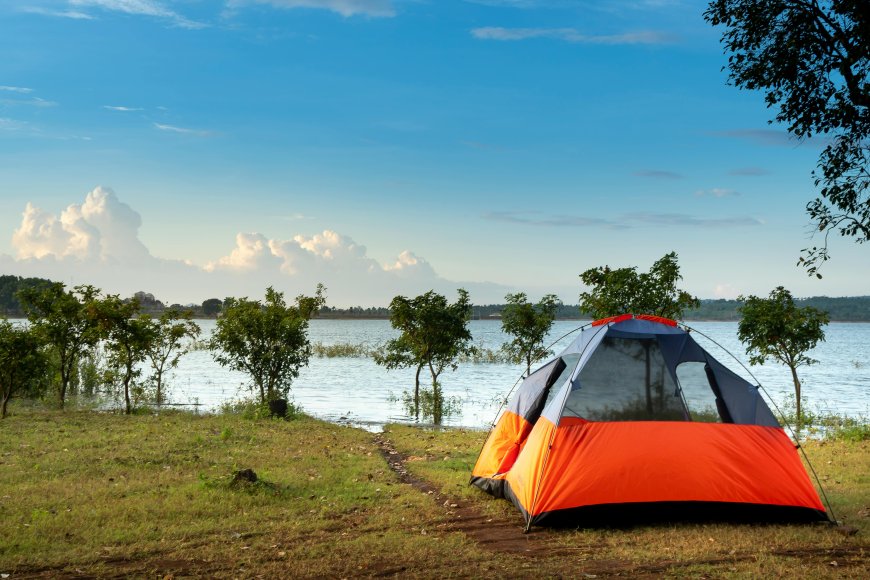Basic Safety Guidelines for Camping Trips
To ensure camping safety, campers must adhere to important guidelines. Firstly, all equipment and food should be stored away from fire and heat sources to avoid unwanted fires. Secondly, the campsite should be properly secured, including securely pitching tents and securing valuable items. Additionally, campers should follow general safety procedures such as avoiding hazardous areas and maintaining cleanliness at the site. By following these guidelines, campers can enjoy a safe and peaceful camping experience.

To ensure camping safety, campers must adhere to important guidelines. Firstly, all equipment and food should be stored away from fire and heat sources to avoid unwanted fires. Secondly, the campsite should be properly secured, including securely pitching tents and securing valuable items. Additionally, campers should follow general safety procedures such as avoiding hazardous areas and maintaining cleanliness at the site. By following these guidelines, campers can enjoy a safe and peaceful camping experience.
Basic Safety Guidelines for Camping Trips
Camping safety is a crucial element to ensure an enjoyable and risk-free camping experience. Basic safety guidelines encompass several aspects aimed at protecting campers and maintaining their safety as well as the safety of the surrounding environment.
First and foremost, campers should prepare thoroughly before embarking on a camping trip. This includes inspecting equipment and tools to ensure their safety and readiness for use. Tents, cooking equipment, lighting, and personal gear such as knives and flashlights should be checked for safety and proper operation.
Next, campers must handle fire with caution. Fires should be placed in a secure location away from tents and flammable materials. Ensuring that the fire is completely extinguished before sleeping or leaving the site is essential. It's also important to check local regulations and laws regarding fire ignition and safety.
Safety doesn't stop at fire; attention should also be paid to food safety. Food supplies should be stored properly to avoid contamination or exposure to insects and wildlife. Fresh and canned food should be stored away from the fire to prevent spoilage.
Regarding personal safety, campers should wear appropriate clothing and footwear for the environment and various activities. They should also avoid hazardous areas such as cliffs, deep valleys, and deep water without supervision.
Ultimately, campers should be environmentally conscious and respect the nature around them. They should pack out their trash and leave the site as they found it, emphasizing leaving nature in its natural state for future generations to enjoy safely.
Essentials of Camping Safety
The fundamentals of maintaining camping safety are essential for ensuring a secure and comfortable camping experience, relying on several critical factors that safeguard campers and their surroundings. In this context, securing the campsite and managing risks are among the most prominent aspects that must be taken into consideration.
To begin with, campers should choose a suitable camping location that ensures their safety. Camping in steep areas or near flowing water sources, which may cause sudden floods or drowning hazards, should be avoided. Additionally, a location with shade and protection from harsh weather elements such as strong winds or storms should be selected.
When setting up the tent, it should be securely anchored to prevent collapse during strong winds or storms. It's advisable to use sturdy tent stakes and anchor them deeply into the ground to enhance tent stability. Furthermore, avoiding placing the tent under dead or collapsing trees is recommended to avoid the risk of injury.
On the other hand, extreme caution should be exercised when using fire. Building a safe campfire and carefully igniting and controlling it is essential to prevent the spread of unwanted fires. Campers should also keep flammable materials away from heat sources and avoid risky handling of fire.
Regarding equipment and tools, they should be properly secured to prevent injuries and accidents. Sharp tools such as knives and axes should be stored out of children's reach and securely fastened in a suitable place. It's also preferable to use approved and durable camping equipment that resists wear and tear.
In summary, maintaining camping safety requires meticulous and cautious measures in choosing the campsite, securely anchoring the tent, controlling fire usage, and properly securing equipment. In this way, campers can enjoy a safe and enjoyable camping experience without suffering from potential risks.
Essential Steps to Ensure Camping Safety
To ensure camping safety, there are several essential steps that must be taken to create a secure and comfortable environment for campers. Let's take a detailed look at these steps
1. Choosing a suitable campsite: Selecting the campsite is a fundamental step to ensure camping safety. A location with flat terrain and free from obstacles such as rocks and dead trees should be chosen. Steep areas that may cause tent collapse or fall accidents should also be avoided.
2. Proper tent anchoring: The tent should be securely anchored using appropriate stakes and guy ropes. Stakes should be placed at equal angles and ropes tightened well to prevent tent collapse or movement during strong winds.
3. Handling fire with caution: When lighting a fire, proper safety procedures should be followed, such as exercising caution in using flammable fuel and directing the fire away from flammable materials and the tent itself.
4. Securing equipment and tools: Equipment and tools should be stored securely to avoid injuries and accidents. Sharp tools should be kept out of children's reach and securely fastened in a suitable place.
5. Avoiding hazards: Campers should identify and avoid potential hazards such as risky areas like deep rivers or slippery slopes. Camping under dead trees that may cause collapse accidents should also be avoided.
6. Cleanliness and personal hygiene: Campers should maintain camp cleanliness and personal hygiene to prevent diseases and infections. Proper disposal of garbage and ensuring cleaning of utensils after use is necessary.
By using these essential steps, campers can ensure camping safety and enjoy a comfortable and safe experience in nature.
Important Guidelines for Camping Safety
1. Choose the site wisely
- Look for a location with flat terrain and free from potential obstacles like large rocks and dead trees.
- Avoid steep slopes and areas close to water sources that may cause sudden floods.
- Seek a site that provides shade and protection from harsh weather elements such as strong winds and heavy rain.
2. Secure the tent properly
- Anchor the tent securely using stakes and guy ropes, ensuring they are placed at the correct angles for better stability.
- Check the strength of stakes and guy ropes before sleeping, and re-anchor if necessary to avoid unwanted surprises.
3. Light the fire with caution
- Choose a safe location away from the tent and flammable materials to light the fire.
- Use safe fuel and ensure control over the fire size to prevent unwanted fires.
4. Secure equipment and tools
- Keep equipment and tools organized and ensure they are out of children's reach.
- Ensure sharp tools are securely fastened and store flammable materials away from heat sources.
5. Avoid potential hazards
- Assess surrounding areas and avoid potential hazards like deep rivers and slippery slopes.
- Avoid camping under dead or collapsing trees to minimize risks of falling.
6. Maintain cleanliness and personal hygiene
- Keep the campsite and personal hygiene clean to prevent diseases and infections.
- Dispose of garbage properly and clean utensils after use to maintain cleanliness.
7. Monitor the weather
- Follow local weather reports and ensure to plan for expected weather conditions.
- Prepare additional supplies and equipment to handle harsh weather conditions as much as possible.
By following these essential guidelines, campers can achieve a safe and enjoyable camping experience, allowing them to enjoy nature without suffering from potential risks.
How to Safely Use and Store Equipment to Ensure Camping Safety
You can enjoy camping safely and ensure the safety of yourself and those around you by following these guidelines
1. Use equipment safely
- Before using any equipment, make sure to understand how to use it properly. Refer to the user manual if necessary and follow the instructions provided.
- Use equipment only for the purposes it was designed for, and avoid using it in ways that may lead to injury.
2. Store equipment safely
- Store equipment in dry and clean places, away from moisture and humidity that may cause rust and damage.
- Use waterproof and dust-resistant storage bags to protect the equipment from harmful environmental factors.
3. Secure equipment at the site
- Before sleeping or leaving the camp, make sure to secure the equipment properly to prevent loss or damage due to wind or animals.
- Store sharp equipment such as knives and axes in a safe place away from children's reach.
4. Regularly check equipment condition
- Before each use, check the condition of the equipment to ensure there is no damage or defects that affect your safety.
- Repair or replace any equipment showing signs of corrosion or performance weakness.
5. Provide guidance for beginners
- If camping with beginners, provide detailed guidance on how to safely use and store equipment.
- Share practical examples and personal experiences to teach them the proper way to handle the equipment.
6. Consider environmental conditions
- Make sure equipment is stored in a place protected from direct sunlight to avoid damage from ultraviolet rays.
- In humid weather conditions, use moisture-resistant storage bags to keep the equipment dry and safe.
Identifying and Avoiding Risks to Ensure Camping Safety
Identifying and avoiding risks is an essential part of ensuring camping safety. Here are the details of this process
1. Identifying Risks
- Before starting camping, identify potential risks that you may encounter during your trip. These risks may include natural factors such as bad weather, hazardous areas like high mountains, and health risks such as insects or venomous reptiles.
2. Assessing the Situation
- Assess each camping risk specifically, determining the impact of each risk on your safety and the safety of others accompanying you on the trip.
- Evaluate your ability to deal with these risks and your readiness to handle potential conditions you may encounter.
3. Developing a Risk Management Plan
- Based on the previous assessment, develop a plan to deal with the identified risks. Discuss the plan with your team or trip participants, assigning roles and responsibilities to each person.
- Specify the necessary actions to take in case any of the identified risks occur, such as contacting emergency services or moving to a safe location.
4. Avoiding Risks Whenever Possible
- Avoid risks that are avoidable whenever possible, such as avoiding camping in areas prone to rockslides or places surrounded by deep water bodies.
- Steer clear of camping in locations experiencing harsh weather conditions like thunderstorms or heavy snowfall if they can be avoided.
5. Proper Preparation
- Prepare thoroughly for the trip by acquiring necessary equipment and supplies, and learning survival skills and first aid.
- Train in using the required equipment and skills to deal with potential risks before embarking on the trip.
By following these steps, you can effectively identify and avoid risks to ensure camping safety and steer clear of hazardous situations that may harm you and others on the trip.
A Guide to Maintaining Environmental and Camper Safety
A Comprehensive Guide to Maintaining Environmental and Camper Safety During Camping Trips
1. Leave No Trace
- One of the most important rules in camping is to leave the site clean after the trip ends. Collect all trash and garbage, and respect the surrounding nature by leaving it as you found it.
- Store garbage in designated bags and leave no trace of it at the site. Carry it with you and dispose of it in appropriate areas.
2. Use Fire Wisely
- When lighting a fire, use designated fire pits and be cautious to prevent unexpected wildfires.
- Ensure the fire is completely extinguished before leaving the site and avoid leaving unattended flames.
3. Conserve and Use Water Carefully
- Provide an adequate amount of water for use during the trip and avoid wasting it as much as possible.
- Store water in designated containers and avoid environmental pollution by not pouring contaminated liquids into freshwater sources.
4. Respect Wildlife
- Avoid interfering with wildlife and respect it by not leaving food unattended in the tent and by handling wild animals with caution.
- Store food in tightly sealed containers to prevent attracting wildlife to the site.
5. Engage with the Local Community
- Before embarking on a camping trip, communicate with local authorities to obtain information about local laws and environmental guidelines.
- Familiarize yourself with local rules and regulations related to camping and environmental conservation, and adhere to them strictly during your trip.
6. Environmental and Cultural Awareness
- Respect local culture and traditions and educate yourself about local environmental practices and natural resources.
- Engage with local residents and inquire about the best ways to preserve the surrounding environment and respect local culture.
By following these guidelines, you can enjoy a safe camping experience while respecting the environment, the local community, and contributing to the preservation of camping safety and nature for future generations.
How to Achieve a Safe and Enjoyable Camping Experience while Ensuring Camping Safety
Here is a comprehensive guide to achieving a safe and enjoyable camping experience while prioritizing camping safety
1. Preplanning
- Carefully plan your trip, from selecting the appropriate location to determining and organizing the necessary equipment.
- Gather local information about expected weather conditions, environmental factors, and local laws related to camping.
2. Careful Site Selection
- Choose a safe and suitable camping location with flat terrain and free from potential hazards and risks.
- Avoid areas prone to floods, rockslides, or places with dense wildlife activity.
3. Basic Equipment Preparation
- Ensure you have all essential equipment such as tent, sleeping gear, food, cooking utensils, and first aid supplies.
- Inspect equipment before departure to ensure its safety and readiness for use.
4. Personal Safety Guidelines
- Adhere to personal safety rules such as no smoking inside the tent and avoiding fire near flammable materials.
- Carry a handheld flashlight and essential emergency tools such as a cutter and small fans.
5. Communication and Reporting
- Exchange information with trip members about emergency plans, meeting points, and communication methods in case of emergencies.
- Inform close contacts about your camping location and expected return schedule for safety purposes.
6. Handle Nature with Caution
- Handle the environment with care and respect to preserve the surrounding nature. Leave no harmful environmental footprint and avoid pollution.
- Avoid leaving food outside the tent to prevent attracting wild animals.
7. Learning and Training
- Acquire necessary skills for handling emergencies such as first aid and fire extinguishing before departure.
- Train yourself in the proper and effective use of available equipment.
By following these steps, you can achieve a safe and enjoyable camping experience while prioritizing personal safety, the safety of others, and preserving the surrounding environment.
Summary
Basic safety guidelines for camping trips are crucial to ensure the safety of campers and the preservation of the environment. Achieving camping safety involves a set of procedures and practices that should be carefully followed.
First and foremost, campers must plan their trip meticulously. This includes choosing an appropriate location with essential amenities such as barbecue sites, sanitation facilities, and drinkable water points.
Secondly, campers should fully and appropriately equip themselves. It is essential to ensure the quality, efficiency, and safety of equipment before departure, with a focus on first aid supplies and basic cooking and sleeping gear.
Thirdly, campers must adhere to personal and environmental safety rules. For instance, smoking inside tents should be avoided to prevent fire hazards, and care should be taken when handling fire and flammable materials.
Fourthly, it is imperative to maintain and respect the surrounding environment fully. Campers should collect all waste and garbage and leave no trace that could harm nature. Furthermore, caution should be exercised around wild animals, and feeding or approaching them should be avoided.
Finally, campers should communicate and cooperate with other members of the trip, exchanging information and assisting in emergencies. They should have a well-established emergency plan and readily available means of communication when needed.
By adhering to these guidelines and instructions, campers can achieve a safe and enjoyable camping experience and fully appreciate nature with the utmost safety and respect.
Sources
1. World Health Organization (WHO) Website
-Safety in Camping and Nature Travel
2. World Organization of the Scout Movement Website
- Camping Safety Guide
3. United Nations International Children's Emergency Fund (UNICEF) Website
- Safety and Health in Camping
What's Your Reaction?




































































































































































